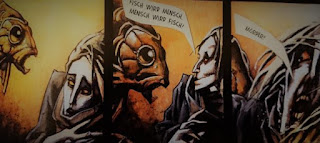 |
| Viriconium comic, in German, by Dieter Judt |
Deep in work-work and in lieu of anything new to say, I'm rehashing this passage from my personal blog.
When I discovered the OSR 18 months ago, it surprised and pleased me to discover how much influence M John Harrison (or at least his Viriconium sequence) seemed to have over the movement. Mike Harrison's writing has significantly altered my views on literature at least twice in my life.
Ironically, I seem to remember Mike once mentioning that he'd heard people were roleplaying a version of Viriconium; he was perplexed as to why and how. At the time I understood that Viriconium was a tricksy illusion, only meant — only able — to exist in its original written medium. I now understand a little better how aspects of Viriconium can seep into a game setting.
So, these are some thoughts I had on Viriconium when the final Viriconium story, “Jack Of Mercy's”, was published (in You Should Come With Me Now)...
Vrico. Pastel City. The City, and the city, and the city
I first came here as a young man. Seventeen. Through a portal in one of those London termini, I’d almost swear it was St Pancras. The old one of tunnels, caves, and condensation in huge waiting rooms. Except there was a bookshop, selling sci-fi.
“M John Harrison”, Simon said, “he’s friends with Michael Moorcock. Or something.” I bought the book, we boarded a train. We crossed the sea to Amsterdam.
I dreamt so many dreams, those seven Viriconium Nights.
Uroconium. The City on the edge of the Western Sea. Canals, and pools, and streets with strange, familiar names. Genever in coffee shops and mystery women at its windows. Scarlet, black, neon. A city that wears its heart on its sleeve, but plays cards close to its chest.
I’ve returned to The City often, sometimes in Amsterdam. And reversed my way through the series of books: Viriconium Nights, In Viriconium (The Floating Gods), A Storm of Wings, The Pastel City. Immersed myself in the graphic adaptations of Ian Miller and Dieter Jüdt. Revisited revised and re-ordered versions.
And now, I’m told, I can glimpse it through one final window, in You Should Come With Me Now, in Jack of Mercy’s. I’m a little afraid of what I may find there.
I’m not sure what pulls me back, and I never seem to find it. You never fill the yearning. Yet there’s always something new, unexpected. Changed.
First I learnt that fantasy needs no heroes, it does not need quests. Happy endings are over-rated; endings too, by and large. Life is not a gift-wrapped package. Stories can be slippery. The map is not… where am I?
Gradually, I became conscious of style, details: names of flowers; species of birds; and, now that I know metalwork, I’m noticing that too. Rarely noble: Tegeus Cromis’s base metal rings, and the steel set of Queen Jane. Iridium birds and planished copper tables. Iron bogs and cadmium wastes. Could “Viriconium” too be some sickly, antediluvian element, tarnished by an earlier civilisation, waiting to be reworked into weaponry and ornament?
"Worked metal was the death knell of them, tolling from the crude and ceaseless smithies of the North."
The shifting things that embed in my mind are the names. People and places, from the Margarethestrasse to the Rue Serpolet. Bistro Californium to the Luitpold Café, where you may find Ansel Verdigris with his fresh dyed scarlet coxcomb, his extraordinary yellow shirt, puking a puddle of lemon genever.
Montrouge to the cisPontine Quarter. Monstrance Avenue to the Plaza of Unrealised Time (or, on some days, the Plaza of Realised Time). The Ghibbeline Stair, the Proton Circuit, and out through, say, the Surgeon’s Gate? Out, perhaps to Iron Chine, to Dunham Massey, to Soubridge, and to the wastes beyond.
[Digression: my grandparents lived next door to Dunham Massey with Eugene Halliday, the Institute for the Study of Hierological Values, ISHVAL, and the International Hermeneutic Society, the IHS; it was a thrill seeing its name appear in my favourite books]
Nobody knows how to reach these places; even less so how to make them stick; some people fade and die from trying. But their names form a thousand cities in your mind. And ruling over many, a Mammy Vooley, a cracked and faded totem; some kind of doll or vanitas, a one-eyed heap of sticks that sings, creaks, whispers: “Stop! I bless all my subjects. Even this one.”
And the senses. Acid yellow, cobalt blue, coxcomb red, all burned in the retinas. The cloying scent of sticky spilt genever. A lingering whiff of blood and fish. These things endure, along with the oxides of the metals.
I have never seen the far side of the Aquelate Pool — has anyone? How big is it? And what is in it? Does it even have a far side?
Some things I reluctantly admit I will never know.
No comments:
Post a Comment